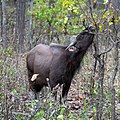Gaur
The gaur is a bovine species, similar to the bison. Bos gaurus (or Indian bison) is the largest living bovine. It is native to South Asia and Southeast Asia.
| Gaur | |
|---|---|

| |
| Bos gaurus | |
| Conservation status | |
| Scientific classification | |
| Kingdom: | |
| Class: | |
| Order: | |
| Family: | |
| Subfamily: | |
| Genus: | |
| Species: | B. gaurus
|
The height up to the shoulder of the male is 175 to 195 cm. When the female is 165 to 185 cm. Has the same height. Length from head to body is 240 to 300 cm. And length 70 to 105 cm. Have. The flowering of horns, which are relatively short cylindrical and have a small roundness on the inside, is about 85 to 100 cm. Mating at any time of the year. New calves are found especially during the months of November to March. Its gestation period is about 270 days.
The pregnant female is separated from her herd. She gives birth to a baby and keeps the baby moving around. The female takes constant care of him. Babies start walking a few minutes after birth. Mother and calf rejoin their herd after being separated for a few days.[2]
The species is listed as vulnerable on the IUCN Red List since 1986. Population trends are stable in well-protected areas, and are building up in a few areas which had been neglected.[1]
The gaur is the tallest species of wild cattle.[3] The Malayan gaur is called seladang, and the Burmese gaur is called pyoung.[4] The domesticated form of the gaur Bos frontalis is called 'gayal' or 'mithun'.[5]
Gaur Media
Bos gaurus grangeri skeleton
Albino gaur or Manjampatti white bison in Chinnar Wildlife Sanctuary, Kerala
A gaur herd at a mineral lick in Nagarhole National Park, Karnataka
A male gaur grazing in the grasslands of Trishna Wildlife Sanctuary, Tripura
A gaur in Satpura National Park, Madhya Pradesh
A gaur herd in Kanha National Park, Madhya Pradesh, India
A gaur herd in Periyar National Park
- Mother and Cub Guar.jpg
Mother and Cub Guar
- Tiger with gaur kill.jpg
Tigers of Central India
References
- ↑ 1.0 1.1 Duckworth J.W. (2008). "Bos gaurus". IUCN Red List of Threatened Species. Version 2012.2. International Union for Conservation of Nature.
- ↑ "Unbelievable Facts About GAUR And Wild Buffalo". Archived from the original on 2021-10-09. Retrieved 2021-10-09.
- ↑ Lydekker R. (1888–1890). The new natural history Volume 2. British Museum (Natural History), London.
- ↑ Hubback T.R. 1937. The Malayan gaur or seladang. Journal of Mammalogy 18 (3): 267–279.
- ↑ Nowak R.M. 1999. Gaur Pages 1158–1159 in Walker's Mammals of the World. Volume 1. The Johns Hopkins University Press, Baltimore, USA and London, UK.

